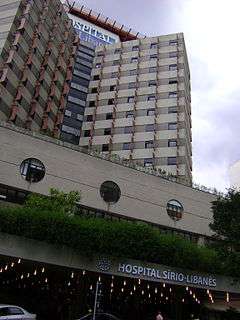Lebanese Brazilians
| Total population | |
|---|---|
| The Brazilian/Lebanese governments claim there are 7 million Brazilians of Lebanese descent.[1][2] However, another study, covering only the states of Amazonas, Paraíba, São Paulo, Rio Grande do Sul, Mato Grosso and Distrito Federal, found only about 2 million Brazilians of any Middle-Eastern ancestry.[3] | |
| Regions with significant populations | |
| Brazil: Mainly in São Paulo State, Minas Gerais, Goiás, Rio de Janeiro, Paraná. | |
| Languages | |
| Brazilian Portuguese, Arabic (Lebanese Arabic) | |
| Religion | |
| Roman Catholicism 65%, Eastern Orthodox Church 20%, Shia Islam, Sunni Islam, Druze 15% | |
| Related ethnic groups | |
| Other Arab Brazilians |
| Part of a series of articles on |
| Lebanese people |
|---|
 |
|
Lebanese people |
|
Communities Native communities outside of Lebanon:
Europe Overseas
Middle East |
|
Language |
|
|
Lebanese Brazilians (Portuguese: Líbano-brasileiros) (Arabic: البرازيلي اللبناني) are Brazilian people of full, partial, or predominantly Lebanese ancestry, or Lebanese-born immigrants in Brazil. Until 1922, Levantine immigrants were considered "Turks", as they carried passports issued by the Turkish Ottoman Empire, which then ruled over present-day Lebanon.[4]
The population of Brazil of either full or partial Lebanese descent is estimated by the Brazilian and Lebanese governments to be around 7 million people.[1][2] According to a research conducted by IBGE in 2008, covering only the states of Amazonas, Paraíba, São Paulo, Rio Grande do Sul, Mato Grosso and Distrito Federal, 0.9% of white Brazilian respondents said they had family origins in the Middle East.[3] If the first figure is correct (7 million), this number of descendants is larger than the population in Lebanon. However, other Middle Eastern countries such as Syria, Iraq, Jordan, and Palestine also contributed immigrants to Brazil, and nowadays, most of their descendants are of only partial Middle Eastern ancestry.
Immigration of the Lebanese (and Syrians) to Brazil started in the late 19th century, most of them coming from Lebanon and later from Syria. The immigration to Brazil grew further in the 20th century, and was concentrated in the state of São Paulo, but also extended to Minas Gerais, Goiás, Rio de Janeiro and other parts of Brazil.
Between 1884-1933 130,000 Lebanese people immigrated to Brazil. 65% of them were Catholics (Maronite Catholics and Melkite Catholics), 20% were Eastern Orthodox and 15% were Muslims (Shia, Sunni and Druze). According to French Consulate reports from that time , Lebanese/ Syrian immigrants in São Paulo and Santos were 130,000, in Pará 20,000, Rio de Janeiro 15,000, Rio Grande do Sul 14,000 and in Bahia 12,000. During the Lebanese Civil War 32,000 Lebanese people immigrated to Brazil.
Although the exact number of Lebanese Brazilians is disputed it is clear that there are at least 6 million Brazilians of Lebanese origin.[5] Despite being estimated at less than 4 percent of the population of the country, descendants of Lebanese immigrants occupied 10 percent of the parliament seats in 2014[5] and 8% in 2015[6][7]
Lebanese culture has influenced many aspects of Brazil's culture. In big towns of Brazil it is easy to find restaurants of Lebanese food, and dishes, such as sfiha ("esfiha"), hummus, kibbeh ("quibe"), tahina, tabbouleh ("tabule") and halwa are very well known among Brazilians.
Most Lebanese immigrants in Brazil have worked as traders, roaming the vast country to sell textiles and clothes and open new markets. Lebanese-Brazilians are well-integrated into Brazilian society.


Notable Lebanese Brazilians
Please see List of Lebanese people in Brazil
See also
References
- 1 2 Brazilian Ministry of Foreign Affaires
- 1 2 "Archived copy". Archived from the original on 2010-11-12. Retrieved 2011-07-04.
- 1 2 IBGE: Características Étnico-Raciais da População
- ↑ Recopilaron casi 200 años de los sirio libaneses en Argentina Archived 2014-09-08 at the Wayback Machine.
- 1 2 Executive Magazine: "How the Lebanese conquered Brazil - Success came through hard work and perseverance" by Joe Dyke July 3, 2014
- ↑ Carvalho, Viviane. "Interview With The Ambassador of Brazil to Lebanon". Home For Lebanon. Retrieved 7 February 2016.
- ↑ Bercito, Diogo. "No Congresso, 8% dos parlamentares têm origem libanesa.". Folha de S. Paulo. Retrieved 7 February 2016.
